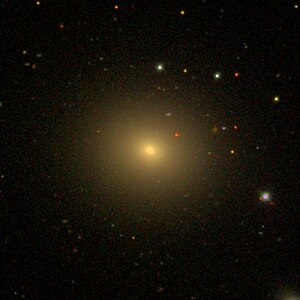NGC 5444
| Galaxy NGC 5444 |
|
|---|---|

|
|
| SDSS recording | |
| AladinLite | |
| Constellation | Hunting dogs |
|
Position equinox : J2000.0 , epoch : J2000.0 |
|
| Right ascension | 14 h 03 m 24.1 s |
| declination | + 35 ° 07 ′ 56 ″ |
| Appearance | |
| Morphological type | E. |
| Brightness (visual) | 11.7 mag |
| Brightness (B-band) | 12.7 mag |
| Angular expansion | 2.5 ′ × 2.0 ′ |
| Position angle | 90 ° |
| Surface brightness | 13.5 mag / arcmin² |
| Physical data | |
| Affiliation | LGG 370 |
| Redshift | 0.013169 ± 0.000033 |
| Radial velocity | (3948 ± 10) km / s |
|
Stroke distance v rad / H 0 |
(179 ± 13) x 10 6 ly (55.0 ± 3.9) Mpc |
| history | |
| discovery | Wilhelm Herschel |
| Discovery date | April 14, 1789 |
| Catalog names | |
| NGC 5444 • UGC 8974 • PGC 50080 • CGCG 191-041 • MCG + 06-31-054 • 2MASX J14032415 + 3507554 • GC 3756 • H II 417 • h 1741 • LDCE 1021 NED011 | |
NGC 5444 is a 11.7 likes bright elliptical galaxy from the Hubble type E2 in the constellation Canes Venatici on the northern sky . It is estimated to be 179 million light years away from the Milky Way and has a diameter of around 130,000 ly.
In the same area of the sky are the galaxies NGC 5440 , NGC 5441 , NGC 5445 , among others .
The object was discovered on April 14, 1789 by Wilhelm Herschel with an 18.7-inch reflector telescope, who described it as "pB, pL, irregularly extended, bM".
